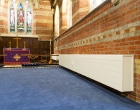Jaga delivers efficient and effective heat for church

St Luke’s Church in Sway in the New Forest is much more comfortable following the installation of Jaga Tempo LST radiators to replace radiant electric heaters suspended from the ceiling. The new heating was installed as part of a major renewable project for the church, built in 1838.
Paul Cantwell of consulting engineeers Worldwise had worked with Jaga on previous church projects and enjoyed complimentary feedback, so he sought Jaga’s input once more.
He explains, We chose the Jaga Tempo LST because we could install the radiators in an unobtrusive, continuous casing along the walls of the aisles and chancel, whilst concealing distribution pipework and providing a safe low surface temperature. Because of the powerful heat output, the radiators successfully offset cold down-draughts from the large stained-glass windows.’
These radiators have Low-H2O heat exchangers, making them a low-mass heating solution. They contain up to 90% less water than conventional steel-panel radiators and use 10 to 15% less energy.
The heating element and brackets were installed first while the outer casings were stored off site for delivery at the final phase of the project.







